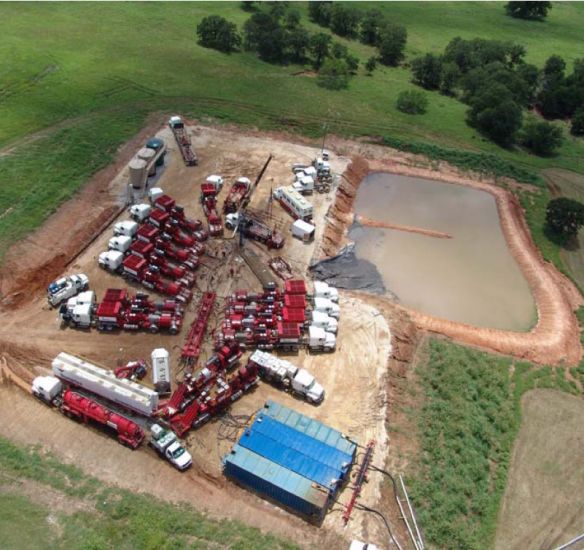The following article was first published on the now defunct Halifax Media Coop site on June 9, 2013. Renewed calls from industry to reconsider the fracking moratorium currently in place have caused author Ken Summers to publish this updated version of his still very relevant article.
KJIPUKTUK (Halifax) – “A natural gas well takes up the same space as a two car garage.” So goes a gas industry ad, part of a propaganda campaign Nova Scotians have been treated to. The claim is true- as far as it goes. But it was intended for soothing our “emotion based” fears of fracking. So it should be looked at in that light.
What hosting shale gas fracking would bring to your community
Unlike a conventional gas well, a single fracked shale gas well can only draw a limited volume from a very limited area. So 6 or 7 producing shale gas wells are packed on to each well pad, and drain about one square kilometre.

There isn’t much footprint to a two car garage. And “wellpad” doesn’t sound huge does it? But these shale gas multi-well producing “pads” are well over a hundred metres square. With the clustered shale gas wells are a host of large storage tanks and other industrial infrastructure. Along with the much better known threat to water quality comes the air pollution and global warming effects from “fugitive emissions”.
Shale gas production is built up one fracked well at a time, with multiple treatments over time for some of the wells. Each of those fracking treatments brings additional industrial infrastructure to the wellpad – drilling rigs, multiple tractor trailer pumper units yoked together, waste ponds, and much more than a thousand truck trips in and out.
And that is just one wellpad, which has pipelines running to the neighbouring wellpads… about a kilometre away in each direction. This gets repeated across the landscape, adding in noisy 24/7 compressor stations to service the pipelines of several wellpads. A fully developed producing shale gas field has 200 to 300 wells, with all the industrial infrastructure that entails. At any given time, several of the wellpads will have yet another active hyper-industrial high volume hydraulic fracturing process to put in a new well, or frack again an existing well.
The economics of shale gas extraction: how it works
That typical industrial infrastructure for shale gas production was described and mapped for the Kennetcook and Noel area in Triangle Petroleum’s June 2008 Development Plan application for the Production Lease it now holds.
From 2007 to 2009 Triangle drilled five wells three, three of them wells receiving high volume hydraulic fracturing treatment. Residents assumed that Triangle gave up because not enough gas was found.
Unfortunately for residents of the communities, this is not at all the case.
Small companies like Triangle Petroleum are the front end of shale gas development. To continue, they depend on investors and co-venturing partners. The company came to Nova Scotia in 2007 at the height of the shale gas frenzy. But the hyper-inflated shale gas bubble was already letting out air by 2008, and industry investors deserted just opening frontiers like the Martimes Basin Shale. Quite simply, without investors Triangle Petroleum had no choice but to shelve its Hants County shale project. So they stopped in the middle of their 2009 drilling program.
Update for 2018
Triangle Petroleum left Nova Scotia for the greener pastures of the fracking boom in North Dakota. They rose with the boom there, and went bankrupt during the bust.
Despite the moratorium on hydraulic fracturing, industry and the province’s Energy Department have not given up on shale gas fracking in Nova Scotia. The recently released Onshore Nova Scotia Petroleum Resource Atlas identifies the development of shale gas in the Windsor-Kennetcook basin, and coal bed methane in the Cumberland-Pictou basin, as the best prospects for the oil and gas industry.
At the moment no company would try to frack for gas in Nova Scotia even if there was no moratorium. But gas prices will rise, and the industry wants to be ready. Pave paradise.
The bull’s eye is still on Kennetcook and Noel.
See also: Fracking company leaves province with the cleanup
If you can, please support the Nova Scotia Advocate so that it can continue to cover issues such as poverty, racism, exclusion, workers’ rights and the environment in Nova Scotia. A pay wall is not an option since it would exclude many readers who don’t have any disposable income at all. We rely entirely on one-time donations and a tiny but mighty group of kindhearted monthly sustainers.




there is a link in the article. but I am wondering if the graphic will appear if I post it here, for the proposed distribution of wells in Kennetcook-Noel. http://halifax.mediacoop.ca/sites/mediacoop.ca/files2/mc/out-of-control-appendix-b_1.pdf
It’s too bad so many are swayed by the lure of economic gain. While the numbers batted around are huge, we don’t have to look far for a different story. Just do an internet search for fracking and Wall St to see what I mean.